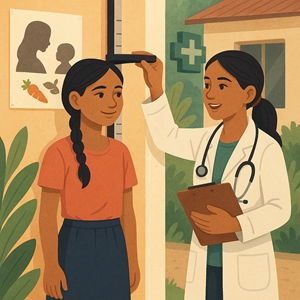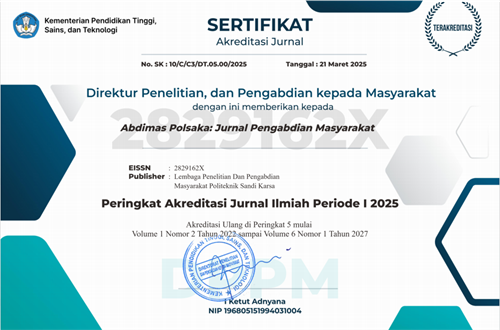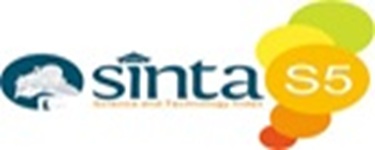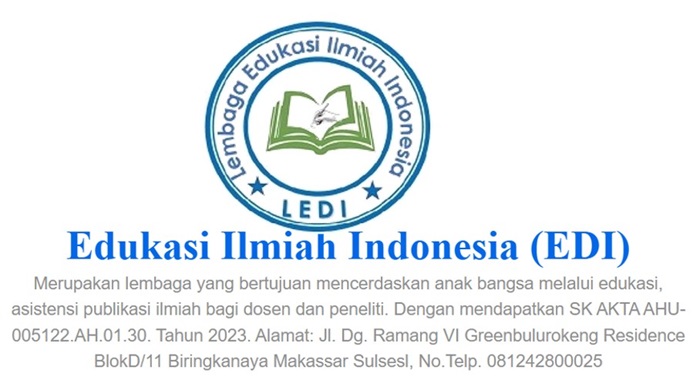Strategies to improve the health of adolescent girls: adolescents are empowered in preventing stunting
DOI:
https://doi.org/10.35816/abdimaspolsaka.v4i2.116Keywords:
Cadre, Knowledge, Adolescent HealthAbstract
Community service activities at the Integrated Service Post for Teenage Girls in Tabukan Raya Village, Tabukan Subdistrict, involved 10 cadres and 17 teenage girls. The event was opened by the Head of Village together with the managing midwife, village midwife, Family Empowerment and Welfare Organization, and cadres from the Integrated Service Post. The cadre training was conducted with pre-tests and post-tests to assess knowledge about adolescent girls' health, particularly the prevention of anemia, stunting, balanced nutrition, and healthy eating patterns. The results showed an increase in the cadres' knowledge about the risk factors for stunting, anemia, consumption of iron tablets, and nutritious foods. Knowledge plays a vital role in shaping health behavior (Lawrence Green's concept), and education is an effective strategy for changing the knowledge, attitudes, and behavior of adolescents. After the education, all cadres had good knowledge. The cadres are expected to be able to become health promotion agents and sources of information for their peers. The results of the adolescent girls' examination showed that there were still 12% with anemia, 47% underweight, 18% with chronic energy deficiency, and 35% short. Adolescence is a second window of opportunity to improve nutrition, as growth occurs rapidly. Anemia is a risk factor for stunting in early adolescent girls, so preventing anemia plays an important role in reducing stunting. Thus, empowering youth integrated service post cadres is a strategic alternative solution in improving adolescent health, especially in preventing stunting, as well as optimizing adolescent reproductive health.
Downloads
References
Kemenkes RI, “Status Gizi SSGI 2022,” BKPK Kemenkes RI, pp. 1–156, 2022.
I. Arifah, L. A. Kusumawardani, D. Hendriyaningsih, M. A. Wibisono, and E. P. Lestari, “The determinants of access to adolescent- friendly health service: a case control study,” J. Adm. Kesehat. Indones., vol. 8, no. 2, p. 164, Sep. 2020, doi: https://doi.org/10.20473/jaki.v8i2.2020.164-174.
A. Permatasari and B. G. Walinegoro, “Pembentukan posyandu remaja sebagai upaya memperkuat penanggulangan stunting,” JMM (Jurnal Masy. Mandiri), vol. 7, no. 3, p. 2553, Jun. 2023, doi: https://doi.org/10.31764/jmm.v7i3.14840.
A. A. Abuosi and E. A. Anaba, “Barriers on access to and use of adolescent health services in Ghana,” J. Heal. Res., vol. 33, no. 3, 2019, doi: https://doi.org/10.1108/JHR-10-2018-0119.
A. G. Nmadu, S. Mohamed, and N. O. Usman, “Barriers to adolescents’ access and utilisation of reproductive health services in a community in north-western nigeria: A qualitative exploratory study in primary care,” African J. Prim. Heal. Care Fam. Med., vol. 12, no. 12, 2020, doi: https://doi.org/10.4102/PHCFM.V12I1.2307.
M. Maslikhah and H. Prajayanti, “POSREM (Posyandu Remaja) sebagai Wadah untuk Edukasi Bahaya Merokok pada Remaja,” J. ABDIMAS-HIP Pengabdi. Kpd. Masy., vol. 4, no. 2, pp. 124–129, Aug. 2023, doi: https://doi.org/10.37402/abdimaship.vol4.iss2.279.
S. T. Marcelina, I. Yudianti, J. J. S. Sondakh, H. Astutik, and Tarsikah, “Pemberdayaan Remaja dalam Mencegah Pernikahan Dini dan Stunting,” J. Dharma Bakti-LPPM IST AKPRIND, vol. 4, no. 2, 2021.
N. S. Sahira and K. S. P. Assariah, “Edukasi dan Pendampingan Program Cegah Stunting,” J. Bina Desa, vol. 5, no. 1, 2023, doi: https://doi.org/10.15294/jbd.v5i1.40777.
N. Wayan Deviani et al., “Program Posyandu Terintegrasi: Strategi Penguatan Posyandu Remaja di Denpasar,” J. Ilm. Ilmu Kesehat., vol. 9, no. 3, 2021.
E. Nurlaela and R. Rasmaniar, “Balanced Nutrition Training for Adolescent Girls as Peer Educators on Improving Behavior among Senior High School Students for Stunting Prevention,” J. Kesehat. Manarang, vol. 9, no. 2, p. 74, Jul. 2023, doi: https://doi.org/10.33490/jkm.v9i2.803.
R. Millati, A. Setyawati, I. Aris Tyarini, and I. Daiyah, “Capacity building of posyandu cadres through education and training in stunting prevention,” Abdimas Polsaka, vol. 4, no. 1, pp. 08–14, Mar. 2025, doi: https://doi.org/10.35816/abdimaspolsaka.v4i1.84.
S. Gado, R. Kempen, K. Lingelbach, and T. Bipp, “Artificial intelligence in psychology: How can we enable psychology students to accept and use artificial intelligence?,” Psychol. Learn. Teach., vol. 21, no. 1, pp. 37–56, Mar. 2022, doi: https://doi.org/10.1177/14757257211037149.
Z. Soltani, B. Zareie, L. Rajabiun, and A. Agha Mohseni Fashami, “The effect of knowledge management, e-learning systems and organizational learning on organizational intelligence,” Kybernetes, vol. 49, no. 10, pp. 2455–2474, Nov. 2019, doi: https://doi.org/10.1108/K-12-2018-0672.
N. N. Abu-Baker, A. M. Eyadat, and A. M. Khamaiseh, “The impact of nutrition education on knowledge, attitude, and practice regarding iron deficiency anemia among female adolescent students in Jordan,” Heliyon, vol. 7, no. 2, p. e06348, Feb. 2021, doi: https://doi.org/10.1016/j.heliyon.2021.e06348.
S. Suprapto, D. Arda, M. Kurni Menga, B. Adji Saktiawan, and S. Nggaá Woge, “OPTIMALCARE: Community-based homecare policy innovation in accelerating stunting reduction in Makassar City,” Abdimas Polsaka, vol. 4, no. 2, pp. 148–156, Aug. 2025, doi: https://doi.org/10.35816/abdimaspolsaka.v4i2.107.
R. A. Jessica and E. Puji, “Knowledge about menstruation with readiness to face menarche of elementary school students in the era of reproductive health education,” J. Ilm. Kesehat. Sandi Husada, vol. 14, no. 1, pp. 174–182, Jun. 2025, doi: https://doi.org/10.35816/jiskh.v14i1.1265.
A. Akhmadi, S. Sunartini, F. Haryanti, E. Madyaningrum, and M. N. Sitaresmi, “Effect of care for child development training on cadres’ knowledge, attitude, and efficacy in Yogyakarta, Indonesia,” Belitung Nurs. J., vol. 7, no. 4, pp. 311–319, Aug. 2021, doi: https://doi.org/10.33546/bnj.1521.
K. Anwar, N. Nurmiaty, D. N. S. Arum, L. Banudi, Y. Yustiari, and A. Arsulfa, “The effect of cadre assistance on the knowledge and attitudes of mothers regarding breastfeeding, complementary feeding, and monitoring children’s growth,” J. Public Heal. Dev., vol. 22, no. 2, pp. 92–106, May 2024, doi: https://doi.org/10.55131/jphd/2024/220208.
Y. Supriati and I. Kusumastuti, “Effectiveness of giving dragon fruit and ambon banana to increase hemoglobin levels in anemic adolescent girls,” J. Ilm. Kesehat. Sandi Husada, vol. 13, no. 1, pp. 41–46, Jun. 2024, doi: https://doi.org/10.35816/jiskh.v13i1.1137.
E. Bongga Linggi, D. Nurhanifah, M. Ihsan Kamaruddin, W. Ode Novi Angreni, S. Suprapto, and Kens Napolion, “Knowledge and Attitude Can Increase Participation in Elderly Posyandu Visits,” Wind. Heal. J. Kesehat., pp. 451–460, Oct. 2024, doi: https://doi.org/10.33096/woh.v7i4.1399.

Additional Files
Published
How to Cite
Issue
Section
License
Copyright (c) 2025 Yuniarti Yuniarti, Zakiah Zakiah, Niken Pratiwi

This work is licensed under a Creative Commons Attribution 4.0 International License.




















